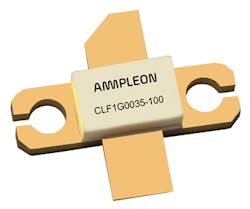Technology Breakthroughs Prepare to Change the World
This file type includes high-resolution graphics and schematics when applicable.
When surveying the microwaves and RF landscape, it becomes apparent that 2016 could be a watershed year for high-impact technology developments. We’ve seen numerous advances in recent years, but many other possibilities still exist that could have a significant impact on every aspect of our everyday lives. As engineers, researchers, and scientists work hard to create tomorrow’s innovations, future technology seems poised to breakthrough on multiple fronts.
Most already know about the fuss concerning the Internet of Things (IoT), as it aims to provide connectivity to the very objects that we use daily. Some predict that we could see tens of billions of connected devices within the next several years. Another talking point is 5G, as future wireless networks could achieve performance levels that far exceed today’s capabilities. Expect a flurry of announcements to spin out through the year as development efforts continue regarding the IoT and 5G.
Although the IoT and 5G are receiving a large amount of attention, other new technologies loom on the horizon. One such example is RF cooking. This concept enables food to be cooked by means of solid-state RF technology, potentially replacing conventional magnetron-based microwave ovens. We may soon see cooking appliances based on this technology arriving in our homes.
In addition, newly structured companies emerging from various mergers and acquisitions in the semiconductor industry will look to push technology forward in 2016 and beyond. On top of that, as gallium-nitride (GaN) technology finds its way into more applications, look for GaN-based products to continue to play a major role in 2016.
5G Technology
Expectations are high for 5G, with the potential for groundbreaking wireless data rates in the purview. However, it also comes with plenty of challenges that must be addressed by researchers. Although it is not expected to be widely deployed until 2020, we will hear plenty of news throughout the year regarding 5G technology developments. Standards have yet to be defined, but a number of solutions are being proposed for 5G.
“The standardization bodies have begun the process of setting requirements for 5G. This includes defining three use cases,” says James Kimery, director of wireless research and software-defined radio (SDR) at National Instruments. “These use cases are enhanced Mobile Broadband (eMBB), massive Machine Type Communications (mMTC), and Ultra Reliable, Low Latency (UL/LL). The 5G goals will be matched to each use case. Many companies and research groups are aligning their investigations toward solving the unique challenges that each use case presents.”
Kimery adds, “The 3rd Generation Partnership Project (3GPP) has divided the 5G standardization into two phases. Phase 1, which will focus on the eMBB use case, will evaluate technologies both below and above 6 GHz. The goal is to define Phase 1 of a 5G standard by mid-2018. Phase 2 will follow 15 months later.”
Although the available spectrum below 6 GHz is nearly depleted, a large amount of spectrum exists in the millimeter-wave bands. As a result, these higher frequencies are being examined as a means to enable future 5G networks (Fig. 1). For instance, at Nokia Networks, researchers have already demonstrated a prototype that consistently streamed data faster than 10 Gb/s at 73.5 GHz.
“To handle the data rates proposed for the eMBB use case, millimeter-wave frequencies must be carefully considered,” says Kimery. “Available spectrum is highly correlated to data rates and capacity according to the Shannon-Hartley theorem. However, not much spectrum is available below 6 GHz. Conversely, spectrum above 6 GHz is plentiful and lightly licensed. The Federal Communications Commission (FCC) recently issued a notice of proposed rulemaking (NPRM) that proposes new flexible service rules in the frequency bands of 28, 37, 39, and 64 to 71 GHz. In comparison to what service operators are using today, the spectrum being proposed is more than 10 times greater.”
Higher-Frequency Requirements
In addition to being considered for future 5G networks, millimeter-wave frequencies are utilized in several current applications, prompting test-and-measurement equipment suppliers to respond to these higher-frequency demands.
“The test-and-measurement market continues to expand with the growing interest in new standards, such as E-band, 5G experimental deployments, and other high-frequency links—for instance, those supporting IoT,” says John Cowles, general manager at Analog Devices. “The need for higher-frequency instrumentation is driving demand for key microwave and millimeter-wave building blocks. Furthermore, test equipment is expected to support multiple standards and require less calibration. These both demand wideband operation with a premium on gain flatness over frequency.”
High-performance millimeter-wave components will also be essential. Cowles adds, “These trends in instrumentation will demand better performance from components. Wideband power amplifiers (PAs), low-noise amplifiers (LNAs), and driver amplifiers must cover multiple bands at frequencies as high as 90 GHz. They also require low harmonic distortion and better efficiency. Synthesizers must simultaneously offer fast- and fine-resolution tuning with low close-in phase noise. Silicon-on-insulator (SOI) switches as well as silicon-germanium (SiGe) up/downconverters and detectors must have wide bandwidths with a flat response.”
The Semiconductor Industry in 2016
By now, most already know about the mergers and acquisitions that occurred in the semiconductor industry. As the dust settles, these newly structured companies will seek to deliver numerous technology solutions in 2016 and beyond. Qorvo, for example, fresh off completing its first year of operation in 2015, plans to shift from 4-in. to 6-in. GaN wafers this year.
Another major shakeup saw NXP Semiconductors recently complete its merger with Freescale Semiconductor. Among the goals of the merged company is to provide technology that will enable self-driving cars.
“NXP will play a key role in making the securely connected self-driving car a reality—much sooner than most people would expect,” says Paul Hart, executive VP and general manager at NXP. “We are accelerating the development of a one-chip solution by leveraging NXP’s position in RF CMOS radar front ends (FEs) and Freescale’s position in radar processing.”
The NXP-Freescale union had further ramifications, as the RF Power business line of the former NXP Semiconductors was sold following the merger’s completion. This transaction resulted in the creation of a new company called Ampleon. Ampleon has assumed responsibility for the former company’s line of products, and already offers a selection of laterally diffused metal-oxide semiconductor (LDMOS) and GaN devices (Fig. 2).
Cree also separated its Power and RF division into a standalone company in 2015. As many already know, the company’s new name is Wolfspeed. It intends to continue providing silicon-carbide (SiC) and GaN technology solutions.
GaN technology not only is a major emphasis of the aforementioned companies, but with several others like Toshiba and Sumitomo Electric Device Innovations. GaN continued its surge in 2015, demonstrated by the arrival of a large number of new GaN-based products. The technology has gained considerable traction the last few years, extending into applications such as satellite-communications (satcom), radar, and cellular infrastructure.
Additionally, suppliers hope to push the capabilities of GaN technology into higher frequencies. For example, Wolfspeed is developing a 0.15-μm process for higher-frequency applications. This will allow the company to reach markets like higher-frequency satcom and wireless backhaul. Qorvo is also developing GaN technology at millimeter-wave frequencies. Higher-frequency performance ties in to 5G, as these future networks will very likely require GaN technology.
The Internet of Things
Everyday objects like lamps, switches, thermostats, fans, coffee makers, vehicles, and televisions could soon connect to the Internet, creating the oft-quoted “smarter and more connected world.” Some are predicting that we may see 50 billion connected devices by 2020. This will undoubtedly have a major positive impact on the semiconductor market, given the enormous amount of IoT devices coming down the road.
Because the IoT spans a wide range of applications, no single technology will be the one and only solution. The list of wireless communication technologies that could enable IoT connectivity includes Wi-Fi, Bluetooth, and ZigBee, to name a few. And wired connections, such as Ethernet, have a role to play in the IoT, too.
Countless wireless sensor networks (WSNs) will be required to support the IoT. A WSN is a collection of distributed sensors that can monitor physical or environmental conditions, such as temperature, sound, and pressure. The data from each sensor then passes through the network.
Linear Technology, for instance, has developed its SmartMesh WSNs for IoT environments. These products comprise embedded chips and pre-certified printed-circuit-board (PCB) modules along with intelligent wireless-mesh-networking software. SmartMesh WSNs represent just one example, as we expect to see more activity in this area.
In addition, test-equipment manufacturers will need to prepare for the demands of the IoT, with wireless connectivity appearing in a vast number of products. One company making strides in this arena is LitePoint. It intends to provide reference test platforms for IoT-specific reference designs, thus streamlining the entire process. It will be interesting to see how the IoT will drive new test methodologies in the future.
RF Cooking
One interesting technology to keep an eye on is solid-state RF cooking, as it could potentially replace magnetron-based microwave ovens in homes. Those developing solid-state RF cooking technology believe it has many advantages when compared with traditional microwave ovens. Two companies leading this charge are NXP Semiconductors and Ampleon.
An RF cooking concept has already been introduced by NXP (at that time, Freescale) (Fig. 3). The concept, which is called “Sage,” can control the amount of heating energy directed into food. This enables more precise cooking that can improve consistency, taste, and nutrition. The cooking concept is based on LDMOS technology.
NXP’s RF cooking appliance can also be seen as a potential IoT-based product. For instance, the oven could access a library of recipes that were written specifically for the appliance and stored in a cloud-based server. Once someone selects one of the recipes, the oven simply cooks the meal based on the instructions. These recipes could be downloaded from cooking websites or social communities.
To summarize, these future technologies could significantly impact each one of us. They could extend into our homes, such as, for instance, the IoT bringing connectivity to our kitchens. Microwave ovens may be usurped by cooking appliances based on solid-state RF technology.
Of course, 5G technology offers many future possibilities. Driverless cars may also be on the road very soon. In addition, GaN technology will assume an even bigger role in new developments, as manufacturers look to push performance capabilities to new levels. It goes without saying that the RF/microwave industry will be at the forefront of tomorrow’s technology.




